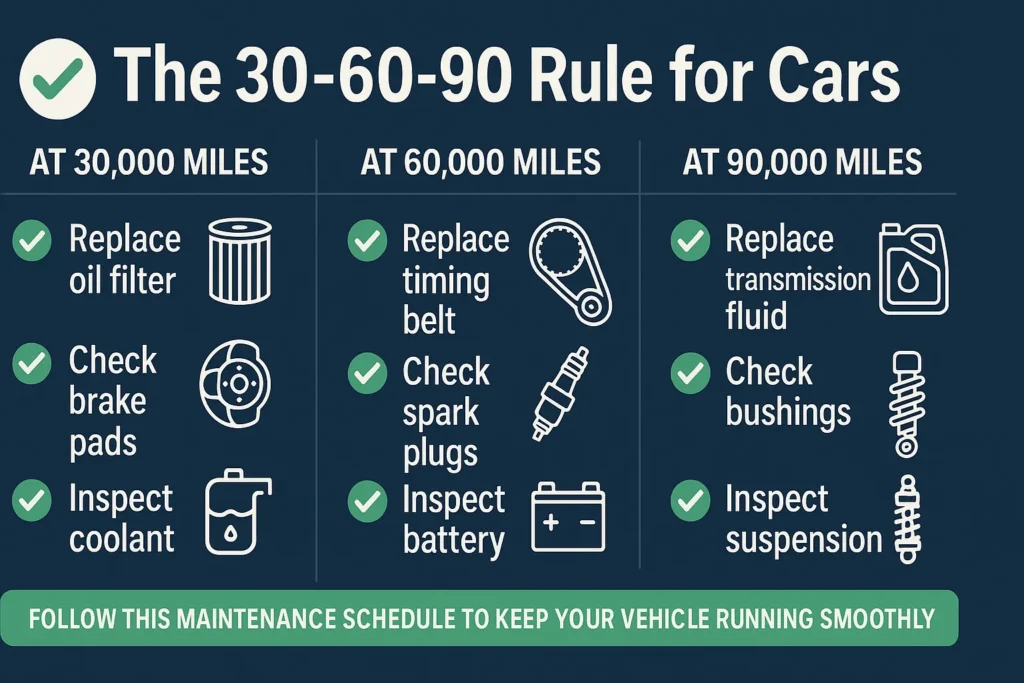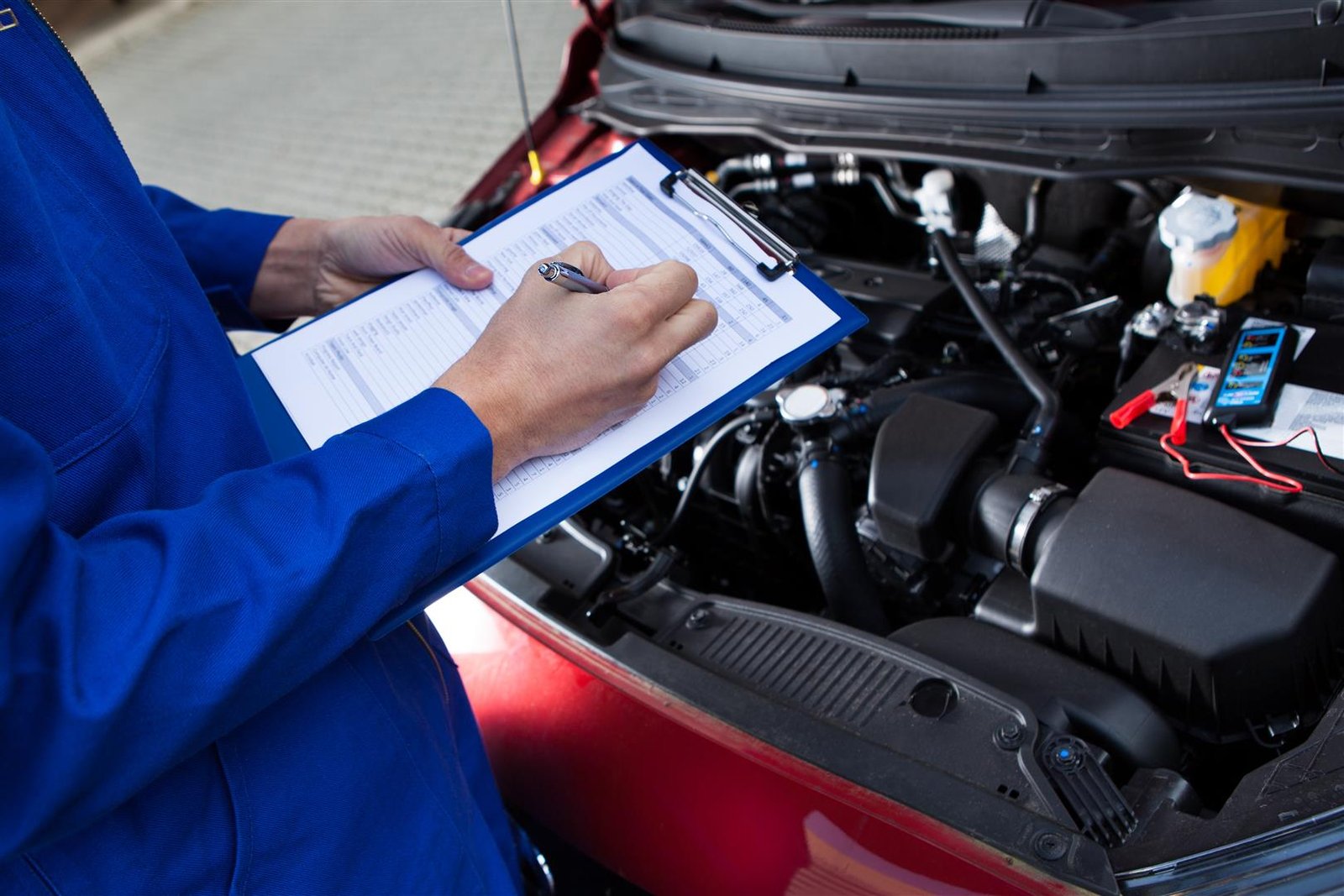Are you tired of costly car repairs catching you off guard? Do you want your vehicle to run smoothly for years to come?
The secret might just be in the numbers: 30-60-90. But what exactly does this mean for your car? Understanding the 30-60-90 rule can transform the way you approach car maintenance, saving you money and keeping your car in top-notch condition.
We’ll unravel the mystery behind these numbers and show you how they can become your roadmap to a healthier vehicle. Stick around to discover how a simple schedule can make all the difference in keeping your car and your wallet happy.
Origins Of The 30-60-90 Rule
When you first hear about the 30-60-90 Rule for cars, you might wonder where this seemingly numerical formula comes from. The origins of this rule are deeply rooted in the automotive industry’s commitment to ensuring vehicles run smoothly and efficiently. It’s a guideline designed to help you keep your car in top shape, and understanding its beginnings can offer insights into its practical application today.
The 30-60-90 Rule emerged from the need for a simplified maintenance schedule that could be easily remembered by car owners. This rule breaks down car maintenance into manageable milestones — every 30,000, 60,000, and 90,000 miles. It’s designed to help you keep track of essential maintenance tasks, ensuring your vehicle operates at its best.
Each milestone represents a point where specific components of your vehicle should be checked or replaced. Car manufacturers developed this schedule based on years of data and engineering insights. The goal was to create a standard that balances vehicle longevity with performance and safety.
Why Car Manufacturers Adopted It
Manufacturers adopted the 30-60-90 Rule to simplify the complex maintenance needs of modern vehicles. As cars became more advanced, they required regular and consistent check-ups. This rule serves as a reminder for car owners to maintain their vehicles, preventing costly repairs down the line.
In my experience, sticking to this rule has saved me from unexpected breakdowns. It’s like having a roadmap for car health. By following it, you can ensure your vehicle remains reliable and efficient.
Practical Benefits For Car Owners
Have you ever been caught off guard by a major car issue? The 30-60-90 Rule can help prevent those situations. It encourages proactive maintenance, helping you address potential problems before they escalate.
For instance, at 30,000 miles, you might need to replace your air filter or inspect your brake pads. By the time you reach 60,000 miles, more comprehensive checks, such as timing belt inspections, might be necessary. This approach not only keeps your car in good condition but also gives you peace of mind.
By understanding the origins and purpose of the 30-60-90 Rule, you can make informed decisions about car maintenance. Does your current schedule align with these milestones? If not, it might be worth considering how this rule could fit into your routine, ensuring your car remains a dependable companion on the road.

Understanding The Concept
Every car owner should know the 30-60-90 rule. It’s a simple maintenance schedule. This method helps keep your car running smoothly. It divides car care into three main intervals. These intervals are at 30,000, 60,000, and 90,000 miles. Each stage has specific checks and services. Following this rule can prevent major issues.
Basic Principles
The 30-60-90 rule is based on mileage milestones. At each milestone, certain tasks are performed. These tasks are crucial for your car’s health. They include oil changes and filter replacements. Brake inspections are also important. These basic principles ensure your car stays reliable. Regular maintenance reduces unexpected repairs.
Purpose And Benefits
This rule aims to extend your car’s lifespan. Regular checks catch problems early. Early fixes are often cheaper. This routine also helps maintain the car’s value. A well-maintained car is more reliable. It provides peace of mind. Fuel efficiency improves with regular maintenance. It saves money in the long run.
Application In Car Maintenance
Understanding the 30-60-90 rule for cars can transform how you approach car maintenance. This simple guideline suggests scheduling maintenance checks at 30,000, 60,000, and 90,000 miles. It provides a structured way to keep your vehicle in top condition, ensuring it runs smoothly and safely. Let’s explore how this rule applies to routine maintenance and its impact on your car’s longevity.
Routine Maintenance Schedules
Think of your car as a trusted partner on your journey. Regular maintenance checks can prevent unexpected breakdowns, keeping your travel plans intact. At 30,000 miles, you might focus on oil changes, tire rotations, and checking the brakes.
By 60,000 miles, consider more detailed inspections, such as replacing the brake pads, inspecting the transmission fluid, and checking the cooling system. These tasks are crucial for avoiding costly repairs later.
The 90,000-mile mark is a critical point. It’s time for a thorough review of your vehicle’s systems. Check the timing belt, spark plugs, and suspension components. Addressing these issues now can save you from headaches down the road.
Impact On Vehicle Longevity
Regular maintenance is more than just ticking boxes. It’s an investment in your car’s future. A well-maintained vehicle can serve you reliably for many years, reducing the risk of major failures and costly repairs.
Imagine driving a car that feels as good as new, even after thousands of miles. With the 30-60-90 rule, this is possible. By staying proactive, you extend your car’s lifespan and maintain its performance.
Would you rather spend a small amount regularly on maintenance or face a significant expense due to neglect? The choice is yours. Applying the 30-60-90 rule ensures you choose wisely, keeping your car—and your budget—healthy.
Next time your odometer reaches one of these milestones, think of it as an opportunity to care for your car. You’re not just maintaining a vehicle; you’re securing peace of mind for your travels ahead.
30-60-90 Rule In Car Financing
The 30-60-90 Rule for cars sets deadlines for loan payments. It involves making payments at 30, 60, and 90 days. This helps buyers manage their finances while securing a vehicle loan.
Purchasing a car often involves understanding complex financial terms, and one of these is the 30-60-90 rule in car financing. This isn’t a magical formula but a practical guideline for understanding loan repayment schedules. It helps you plan your finances and avoid surprises as you pay off your car loan. Let’s dig deeper into what this rule means for you.
Loan Repayment Structures
The 30-60-90 rule refers to common loan term intervals—30, 60, and 90 months. Choosing between these terms depends on your financial situation. Shorter terms like 30 months mean higher monthly payments, but you pay less interest overall. On the other hand, 90-month terms might offer lower monthly payments, but you end up paying more in interest over time. Consider your monthly budget and future financial goals before deciding. A friend of mine opted for a 60-month loan to strike a balance between manageable payments and total interest paid. How would you feel about a longer loan term with more interest versus a shorter one with higher payments?
Impact On Financial Planning
Understanding the 30-60-90 rule is crucial for your financial planning. It helps you forecast your monthly expenses and determine how a car loan fits into your overall budget. If you’re planning for other financial goals, such as buying a house or saving for retirement, this rule can guide you in making informed decisions. Think about how a car payment will impact your disposable income. Would a higher payment limit your ability to save or invest? One wrong decision can lead to financial stress, so it’s important to weigh your options carefully. Have you considered how different loan terms might affect your financial future? By understanding these aspects of the 30-60-90 rule, you can make smarter decisions about car financing that align with your financial goals.
Comparing To Other Automotive Guidelines
The 30-60-90 rule for cars outlines maintenance checks at specific mileage intervals. These checks help ensure vehicle longevity and safety. Regular inspections at 30,000, 60,000, and 90,000 miles focus on vital components.
When it comes to maintaining your car, you might have stumbled upon various guidelines promising to keep your vehicle in peak condition. One such guideline is the 30-60-90 rule, which suggests specific maintenance tasks at every 30,000, 60,000, and 90,000 miles. But how does this rule stack up against other automotive maintenance methods? Let’s dive into a comparison that will help you understand its place in the world of car care.
Differences With Traditional Methods
Traditional car maintenance often follows a more general schedule based on time rather than mileage. You might be used to getting your oil changed every three months or having a check-up every year. The 30-60-90 rule, however, is mileage-based, ensuring that your car’s specific needs are met as you drive. This can be particularly beneficial for those who drive long distances regularly. While traditional methods offer flexibility, the 30-60-90 rule provides a structured plan tailored to your driving habits. Which approach do you think suits your lifestyle better?
Advantages And Disadvantages
Advantages: – Predictability: You know exactly what maintenance tasks are needed at each mileage interval. This takes the guesswork out of car care. – Comprehensive Care: The rule covers all major systems in your vehicle, from the engine to the brakes. – Peace of Mind: Following a structured plan can reduce the risk of unexpected breakdowns. Disadvantages: – Rigidity: If you don’t drive often, you might find the schedule too stringent, potentially leading to unnecessary expenses. – Complexity: Not all vehicles require the same tasks at the same mileage. You might need to adjust the rule to fit your car’s specific needs. – Overmaintenance: Following the rule strictly might lead to changing parts that still have life left in them. Have you ever found yourself wondering if you’re doing too much or too little when it comes to your car’s maintenance? Balancing between structured guidelines and your vehicle’s unique requirements can be a challenge. Ultimately, the choice between the 30-60-90 rule and traditional methods depends on your driving patterns and personal preferences. Whether you’re a road warrior or a casual commuter, understanding these differences and weighing the pros and cons can help you make informed decisions about your car’s care.
Organizations like the National Highway Traffic Safety Administration (NHTSA) emphasize proper vehicle care as a crucial part of road safety.
Common Misunderstandings
The 30-60-90 rule for cars is a guideline to help car owners remember when to perform routine maintenance on their vehicles. It suggests servicing your car at 30,000, 60,000, and 90,000 miles. While this rule seems straightforward, there are several common misunderstandings that can lead to confusion and costly mistakes. Understanding these misconceptions is crucial for ensuring your vehicle’s longevity and performance.
Misinterpretation In Practice
Many people assume that the 30-60-90 rule is a one-size-fits-all approach. However, this isn’t always the case. Different car models may require unique maintenance schedules based on the manufacturer’s specifications. Blindly following the 30-60-90 rule without consulting your vehicle’s manual can lead to either over-servicing or neglecting essential checks.
Imagine taking your car for an oil change at 30,000 miles, only to be told by the mechanic that your model actually needs it every 10,000 miles. You might feel that you’ve wasted time and money. It’s essential to personalize your car care routine according to its specific needs, not just a generic rule.
Clarifying Common Confusions
Another common confusion is thinking the 30-60-90 rule covers all types of maintenance. In reality, this guideline primarily focuses on major services like changing air filters, checking brakes, and inspecting tires. Routine checks like oil changes might occur more frequently, based on your driving habits.
Consider this: if you frequently drive in harsh conditions, like dusty or muddy roads, your car might need additional attention beyond the 30-60-90 milestones. Ask yourself, are you adjusting your maintenance schedule based on your unique driving environment?
Moreover, the rule often gets mistaken for a strict rule rather than a flexible guideline. While it serves as a helpful reminder, it’s crucial to stay informed about your car’s specific needs and adapt accordingly. Ignoring unusual sounds or dashboard alerts just because you’re not at the 30,000-mile mark yet could lead to bigger issues down the road.
Ultimately, understanding the common misconceptions surrounding the 30-60-90 rule empowers you to make informed decisions about your vehicle’s care. Are you ready to tailor your car maintenance routine to fit your lifestyle and your vehicle’s unique demands?
Expert Opinions
The 30-60-90 rule guides car maintenance schedules. It recommends checks at 30,000, 60,000, and 90,000 miles. This helps keep vehicles in top condition and ensures longevity. Regular inspections can prevent costly repairs.
Understanding the 30-60-90 rule for cars can be a game-changer in how you manage vehicle maintenance. This rule is not just a set of numbers; it’s a strategic approach that many experts swear by. By focusing on expert opinions, you’ll gain insights into why this method is trusted by automotive professionals and how it applies in real-world scenarios.
Insights From Automotive Professionals
Leading mechanics often emphasize the importance of regular car maintenance. The 30-60-90 rule provides a structured schedule for your vehicle’s upkeep, ensuring long-term performance and safety. Imagine a mechanic recommending this rule based on years of experience. They might say, “Following this schedule is like giving your car a regular health check-up. It prevents surprise breakdowns and saves money in the long run.” This expert advice can help you avoid costly repairs and keep your car running smoothly.
Real-world Applications
You might be wondering how this rule applies to your daily driving experience. Let’s break it down. Every 30,000 miles, you should check your car’s air filter, fuel filter, and inspect the battery. At 60,000 miles, focus on the spark plugs, brake pads, and your transmission fluid. By 90,000 miles, it’s time to look at the timing belt and coolant system. These intervals are not just numbers. They represent crucial checkpoints that can extend your car’s lifespan. Consider your own driving habits. Do you often take long road trips or drive in harsh weather conditions? Adjusting this rule to fit your lifestyle can offer even more benefits. What might happen if you skip one of these intervals? The answer could be an unexpected breakdown. Isn’t it better to invest a little time now to avoid bigger problems later? Your car’s longevity might depend on it. Remember, a well-maintained vehicle is not just about functionality; it’s about peace of mind. So, what steps will you take today to ensure your car stays in top shape?

Credit: www.monkeyauto.com
Future Of The 30-60-90 Rule
The 30-60-90 rule for cars has guided vehicle maintenance for years. It recommends servicing vehicles at 30,000, 60,000, and 90,000 miles. But the automotive landscape is changing. With new technologies and trends, the future of this rule is uncertain.
Evolving Automotive Trends
Electric vehicles (EVs) are becoming more popular. They require different maintenance schedules. Traditional engines need oil changes. EVs don’t. This could alter the 30-60-90 rule. Advanced driver-assistance systems also need regular updates. These updates might not fit the old timeline. Connectivity features in cars are increasing. They require software checks more often. These trends suggest new maintenance approaches are necessary.
Potential Changes In Approach
Manufacturers might adjust service intervals. They could base them on vehicle usage. Tailored maintenance plans might emerge. They could focus on specific car systems. Predictive maintenance technology is advancing. It uses data to forecast when parts will fail. This could make fixed intervals obsolete. The focus might shift to real-time monitoring. This ensures vehicles are always in top condition.
Frequently Asked Questions
What Is The 30 60 90 Rule For Car Maintenance?
The 30 60 90 rule suggests car maintenance every 30,000, 60,000, and 90,000 miles. Regular checks include oil change, tire rotation, brake inspection, and fluid top-ups. Following this schedule helps maintain vehicle performance and longevity.
What Is The 20/3/8 Rule For Buying A Car?
The 20/3/8 rule suggests a 20% down payment, financing for no more than 3 years, and monthly payments under 8% of your income. This guideline helps ensure affordability and financial stability when purchasing a car.
What Is The 12 Second Rule For Cars?
The 12-second rule for cars suggests scanning the road 12 seconds ahead. This enhances safety by identifying potential hazards early. Drivers have more time to react, reducing accidents. This technique promotes proactive driving and better decision-making, ensuring safer journeys. Always stay focused and adjust speed accordingly for optimal safety.
What Is 30-60-90 Maintenance?
30-60-90 maintenance involves scheduled service at 30,000, 60,000, and 90,000 miles for vehicle upkeep. It includes checking fluids, brakes, and belts. Regular maintenance ensures optimal performance, safety, and longevity of your vehicle. Consult your vehicle’s manual for specific service recommendations and requirements.
Conclusion
The 30-60-90 rule helps you maintain your car effectively. Regular maintenance at these intervals ensures safety and reliability. It prevents unexpected breakdowns and costly repairs. Following this rule can extend your car’s lifespan. Your car will run smoothly and efficiently with timely check-ups.
Don’t overlook minor issues; they can become big problems. Keep a maintenance schedule to track these key milestones. This rule is simple but crucial for vehicle care. Understanding it makes you a more responsible car owner. Stay informed, and your car will thank you.
Check out our other articles, What is the 12-Second Rule for Cars and What is the 80/20 Rule for Cars, for safe car driving.















